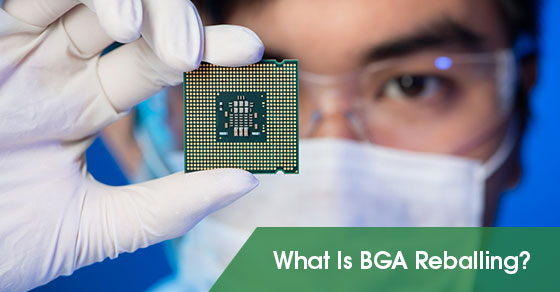What Is BGA Reballing?
BGA reballing involves changing every soldered ball on a grid array circuit. There are many reasons why a chip will need to be reballed, which we will explore in this article. We will also focus on what BGA reballing is, as well as the effects of poor solder joints. We will also explore the four main reasons why engineers will often resort to BGA chip reballing to rectify multiple issues, as well as delve into the actual BGA reballing process itself.
What is Reballing?
A ball grid array circuit is manufactured by an engineer so that they can make an accurate connection between the Printed Circuit Board (PCB) and the chip itself. In some cases, an older ball joint will necessitate the recreation of the ball solder joints by the engineer, so that work can be extracted from that particular BGA chip.
Generally speaking, this process will involve extracting all of the obsolete solder balls and replacing them with new ones. It should also be noted that reballing will usually be performed on a gaming console, laptop, and PC motherboards, with the culprit generally being the video graphic chip or VGC.
It should also be mentioned that VGCs are often considered unlucky in the industry because they are prone to solder joint breakage and often require multiple repairs throughout their lifespan. Even the latest BGA circuit chips in the industry will eventually need to be reballed either due to faultiness or a breakage.
How Bad Solder Joints Impede Performance
You may notice when watching a video or playing a game on your computer system or console that the screen suddenly goes black. In many cases, the “blank screen of death” is the result of bad solder joints. You may also notice horizontal or vertical dots or lines on the screen, which may also be the result of a poor solder joint. Thus, in order to get the system to boot as intended, BGA reballing may be required.
Why a BGA Chip May Need Reballing
The first reason is overuse. That is, the overuse of a graphics chip, which may involve running it for a prolonged time or extended use into several days, may require BGA reballing. More often than not, the solder joints between the PCB and the chip will become loose over time. The result is the user may notice display issues, which will get worse over time.
BGA chips may also become faulty, which will require that the user replace them with a new one. A PCB motherboard may also need a BGA chip upgrade to augment performance or handle the new software.
Finally, overheating may require that a BGA chip be reballed. That is, chip overheating may result in the solder ball becoming hot, which may cause it to loosen and change its location in time. In fact, in a worst-case scenario, the solder may form a solder bridge, which will effectively kill your PC if left untreated.
The BGA Reballing Procedure and Supplies
Several tools will be required for reballing to succeed, as well as sufficient knowhow and technical prowess, which is why professionals usually perform BGA reballing. However, there are BGA rework machines and kits that are available for purchase on the market.
In order to reball a BGA, you will need a soldering iron. A soldering iron is a hand-based apparatus that is designed for soldering projects. It will send heat to the solder metal so that it can be melted to optimize flow into the broken joints between the electronic component and the PCB itself. A soldering iron is crafted so that each unit includes a handle that is well insulated as well as a sufficiently heated metal tip.
Soldering paste or wire will also be needed and is used to affix circuit board pads to surface-mounted components. It is frequently used by manufacturers in order to manufacture various printed circuit boards and is very useful for attaching solder balls or electronic components onto the mounting area.
Desoldering wire is also required, and may also be used to solder wick or to desolder it. It can be purchased in a roll form on the market and is usually braided with 18 to 42 AWG copper wire that is insulated with leading-edge rosin flux. The desoldering wire is designed to remove the solder from the joint by soaking the metal solder in it.
The chips that are reballed will also require a holding stand, and you can purchase a BGA chip case at a low cost on the market. You will also require a chip stencil, which is basically a metal sheet that has many holes in it so that solder balls can be fitted. Made with very high-quality steel, it can be heated either with the BGA machine itself or a hot air gun if desired. Regardless of which option you go with, the end result is that the ball soldering process will be both quick and easy.
Solder balls will also be needed, and consist of small balls of solder that are strewn about the SMT board surface in an arbitrary manner. The purpose of solder balls is to provide a point of contact between the multichip modules and the stacked packages, as well as between the PCB and the chip package.
Finally, a top of the line BGA reworking machine will be needed to finalize the BGA reballing process and is designed to generate large amounts of heat. It can also be used to either remove BGA chips or attach them.
If you would like to learn more about BGA reballing or require BGA reballing for your projects, call Circuits Central at 1-888-821-7746 or contact us here.

